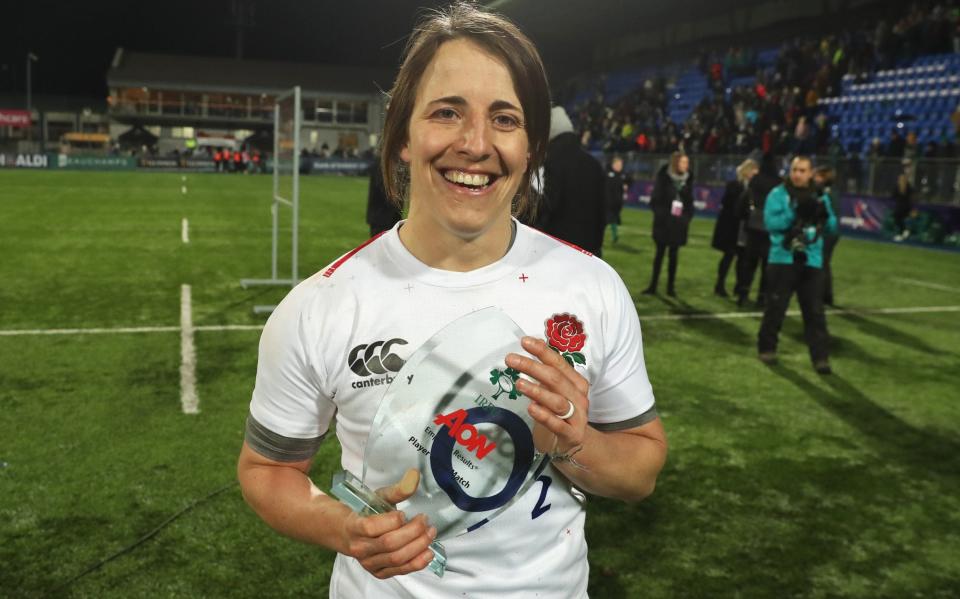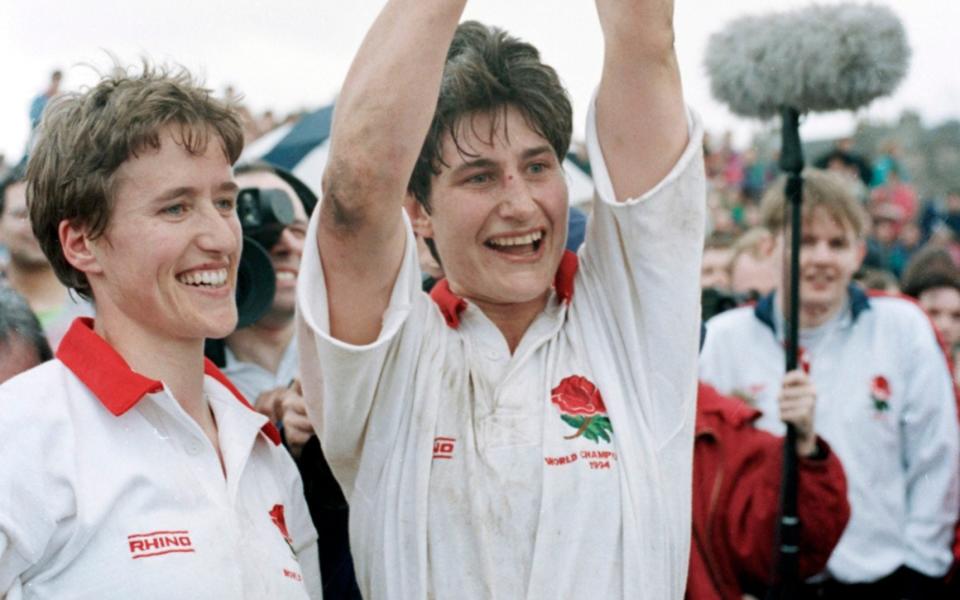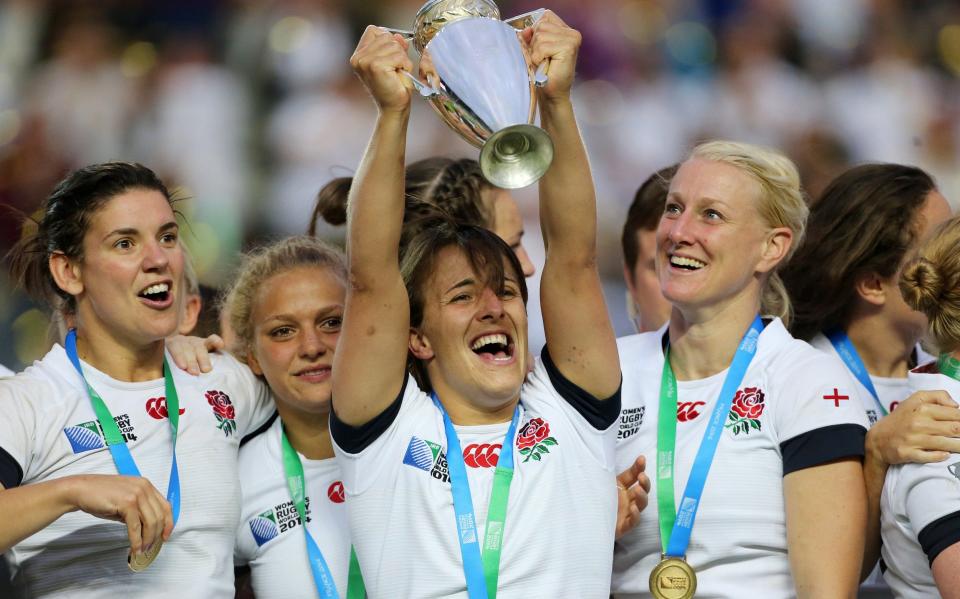Within seconds of their faces coming into view, Karen Almond tells Katy Daley-Mclean, “My dad sent me articles about you. He always said we were quite similar – ‘Ooh, that number 10 who plays for England just like you…’”
This is the first time the pair have met, albeit over a video call rather than in person, and they certainly have a lot in common. Their birthdays are just one day apart: December 18 for Almond and December 19 for Daley-McLean; they both have links with Loughborough University – Almond as a student, Daley-Mclean as a player for Lightning; they both worked as teachers; they both played at fly-half; and they both captained England to Women’s Rugby World Cup glory, beating North American opposition in the 1994 and 2014 finals respectively.
Still, we bring the two women together as we celebrate the milestone anniversaries of those triumphs – next Wednesday, April 24, will mark 30 years since Almond lifted the trophy in Edinburgh, while August 14 will mark 10 years since Daley -Mclean (then just Mclean) did the same in Paris – also highlighting the differences in their careers and how much the game has changed and continues to change.
Take their introduction to rugby. Almond’s first love was football and she also did a lot of athletics (Loughborough appealed as a university destination because Sebastian Coe’s coach George Gandy was there). She only discovered rugby when she was encouraged to give it a try as a student and says: “I was hooked from that first training session. I was like, ‘Woah, you can tackle and run with the ball.’ It was great, I just loved it. And I loved the camaraderie and team spirit.”
In contrast, Daley-Mclean was immersed in the sport from a young age, with her father, uncle and cousin all playing. She jokes that she “grew up on the edge of a rugby field” and started playing at the age of five. However, when she turned twelve, she could no longer play mixed rugby and did not return to the sport for four years. “At 12 there was nothing – the game just stopped [for girls],” she says. “I played county hockey and at 16 rugby came back into the picture with a tag tournament. I was probably a bit p—– [off] with the game – ‘You got rid of me when I was 12’ – but I realized if I ever did anything at a higher level it would be rugby.”


Daley-Mclean’s forced break is indicative of the obstacles women and girls often face in sports. Almond and her generation faced a similar challenge when they left college, on top of inherently sexist attitudes. Although there were several student teams in the early 1980s, there was no club structure in women’s football and they had to find a place to play. Almond describes how one of her team-mates, Sue Martineau, wrote to several men’s rugby clubs to convince “these alickadoo men” to introduce a women’s arm – and Wasps agreed. “We basically based our entire career, job and life around where we could play rugby at the time. And we had to do everything ourselves.”
Pay to play
That ‘can-do’ mentality is also clearly visible when it comes to the Women’s World Cup. It was the actions of four Richmond players – Alice D Cooper, Sue Dorrington, Mary Forsyth and Deborah Griffiths – that got the inaugural tournament off the ground in 1991, while three years later it was the Scotland side that intervened when the Netherlands withdrew as host, organizing the World Cup in just 90 days.
The English players were used to organizing their own matches and also paying for everything that came with it, whether it was equipment, transport or accommodation. “We were just living in our overdraft at that time,” Almond says.
For the 1994 tournament they upgraded from their usual hostels to the George Hotel in Edinburgh, with Almond saying: “We felt quite important, quite professional, to be staying in a hotel.”


In terms of training in preparation for the tournament, they had a few weekend camps in Loughborough and took part in ad hoc gym programs they created for themselves. However, the two weeks of the World Cup itself (yes, England played their five matches in just a fortnight) was the longest period they had ever spent together as a team.
Twenty years later, the women’s game was still amateur, but the first small steps towards professionalism were being taken. The England squad had regular four-day camps and in June, two months before the World Cup, they met full-time, with players given “a bit of money to use however you wanted” to take time off work.
Daley-Mclean merged hers to finish the school year early. Before June, she had gotten used to getting up around 5:30 a.m. to go to the gym before going to work to teach and returning to the gym for a second session at the end of the school day.
As for their accommodation and transport, that was all organized in 2014 by the Rugby Football Union and International Rugby Board (now World Rugby). England decided to set up shop in a hotel on the outskirts of Paris and, in a sign of how far women’s Rugby had come in those twenty years, they even brought their own gym with them, with the equipment being transported over and set up in a nearby school .
Final settlement
Almond’s England were well aware of the challenge that awaited them in the final at Raeburn Place in 1994. After all, they had been defeated by the United States at the same stage of the opening tournament three years earlier. That same year, 1991, England’s men bowed to criticism for their forward-dominated playing style on their way to their own World Cup final and subsequently lost to Australia; the women’s team would not make that mistake in 1994, winning 38-23.
“We were mentioned in the press for playing more in the forwards, but we had to do it to win games,” says Almond. “The American backs were great. We focused on keeping the ball to their backs as much as possible; we had to play with our limitations and our strengths. Our pack was great that day.”
The final whistle caused “complete chaos” as many of the 6,000 spectators rushed onto the pitch to join in the celebrations. Scottish men’s prop David Sole presented the trophy, while the crowd parted to allow Almond and vice-captain Janis Ross to collect the trophy.
By the time Daley-Mclean took the stage for a more formal presentation after England’s 21-9 win over Canada twenty years later, she was presented with another piece of silverware when the IRB introduced a new trophy in 1998 when they officially approved the women’s trophy . tournament.


While the 1994 party was cut short by a fire alarm at the post-match meeting – “A lot of people were tired and by the time we all got back in it had gone dark,” Almond recalls – the 2014 involved drinks . French bar dries and takes the trophy for a dip in the hotel pool. The team bus stopped at the aforementioned bar full of England fans, who had to go to a supermarket to replenish beer supplies, and it was a chance to share their achievement with friends and family, as well as the former players who had missed the previous edition. tournaments (England lost three consecutive World Cup finals before winning a decade ago). “For me that World Cup wasn’t about us, it was about the history of English women’s football and being able to lose that story of being bridesmaids and never brides, so it was quite cool to be able to share that. that,” says Daley-Mclean.
Next stop 2025
It will take just over a year before the next World Cup starts. Both Almond and Daley-Mclean point out that the previous women’s tournament in England in 2010 was huge for the sport. More than 13,000 people filled the Stoop for that final, which England lost 13-10 to New Zealand, and Almond says: “All those people watching women’s sport were fantastic. It was a turning point for rugby in Britain.” Now we hope to sell out the 82,000 seats at Twickenham for next year’s showpiece event.
However, it’s not just the crowds that are changing. More countries are introducing professional women’s programs in some form, and England is leading the way with 32 Red Roses players now contracted by the RFU. The new maternity policy that has benefited Abbie Ward and Vickii Cornborough is another area Almond brings up: “Maternity leave? How futuristic that would have seemed in 1994.” Daley-Mclean adds: “It was the same in 2014. If you had a family you would retire.”
Despite all the positive points, both women also warn about the future. Almond says: “I just hope that the professionalism doesn’t spoil the game because sometimes I feel like girls these days are dictated to where they can play for a reasonable amount of money by who has a contract and who can pay them. Wasps, my club, had to leave the top flight last year due to money problems. That was sad because they were one of the teams from the beginning.”
Daley-Mclean is wary of “outdated attitudes” in some areas of the game and the likelihood of large winning margins at next year’s expanded 16-team World Cup. “It’s really important that the story is told from the beginning about what those opportunities are about for those countries, and it’s about giving them that exposure and a path to 2029 so they can close those gaps. You don’t want to lose new fans because all they see are big scores.” It’s worth adding that big scores were also achieved at the Men’s World Cup last year.
For anyone looking forward, it’s important to look back and recognize how players like Almond shaped the sport. It’s something Daley-Mclean is quick to do after hearing about the sacrifices these early generations made and the sexism they endured.
“If these guys hadn’t done what they did, I certainly wouldn’t have had the career that I have and the girls certainly wouldn’t have had the opportunities that they have today,” she says. “It’s amazing to think about what those guys created. You made our game and people like me will be forever grateful for that.”